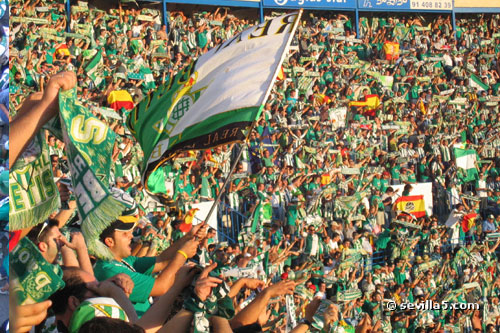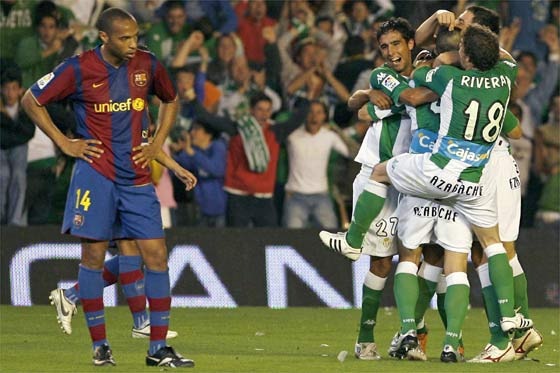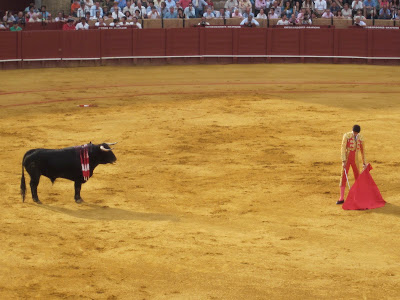After several months in Seville, I found myself with a dwindling amount of remaining time and many more feats to accomplish. Prior to departing for America, I knew that I wanted to experience a traditional Spanish bullfight and that I wanted to partake in the lunacy that is European football. Fortunately, I was able to strike both events from my list in the span of 27 hours.
My First Soccer Game
 |
| Estadio Benito Villamarín. Unfortunately, I neglected to bring my camera to the game, so all pictures will be obtained from the internet. |
On a whim, my friend Erik and I made our way to the outskirts of Seville to check out the masses at Estadio Benito Villamarín. The stadium is the home to Real Betis Balompie, Seville’s perennially second-tier football club. Betis has been playing second fiddle to FC Sevilla ever since the team’s inception in 1907: two years after the founding of Sevilla. In fact, Betis has been bottom-feeding in the Second Division of Spanish soccer for many years after several glorious decades in La Liga, Spain’s premier soccer league, in the mid-20th century.
Yet, Erik and I picked an opportune time to go see Betis play, as the team was coming off a remarkable season that included a momentous blowout of FC Barcelona (the eventual winners of the Champions League, Europe’s most prestigious soccer tournament) and enough victories to promote Betis once again to La Liga for next season. Not to mention, Erik and I were in attendance at Betis’ last game of the season, in which Betis had the chance to clinch the Second Division title with a victory, an exclamation point atop a fantastic season. Erik and I picked up tickets from a scalper for a measly 15 euros, but we were not ready to enter just yet: Erik was wearing a Portland Trailblazers jersey and I was wearing a Vampire Weekend t-shirt, so our “American-ness” was overly blatant. We both agreed that we had to show support for our newfound team and purchase a couple of mementos to use during the game. Erik opted for a typical football scarf that showed off the bright green and white colors of Betis, while I selected a large flag to wave during the game.
 |
| Betis players celebrating a monumental victory over FC Barcelona. |
When Erik and I entered and located our seats, we could not believe our vantage point. We were starkly centered at midfield with only eight rows separating us from the field. Yet, we soon realized why our seats were so cheap as the high sun was bruising and brutally hot. Five minutes before game time, Erik and I made a crucial and clutch decision: we disrobed and covered ourselves in our new Betis gear. Erik tied the Betis scarf around his temple, reminiscent of Ralph Macchio in “The Karate Kid” (1984) and I knotted the Betis flag around my neck, mimicking the caped superheroes of Marvel fame. Otherwise shirtless, Erik and I stood tall, cheering like the lunatic “hinchas,” Spanish soccer hooligans, who flooded the stadium as our soon-to-be idols entered the stadium. I could tell immediately that the Betis players loved performing in front of their home crowd; the energy in the stadium was electrifying as fans called out the names of players and sang fight songs to intimidate the opposing FC Huesca.
As the game got underway, this energy immediately turned into hysterics as Betis scored a beautiful crossing goal five minutes into the match. Erik and I high-stepped down the aisles high-fiving strangers as if we had been cheering for Betis since the womb. The songs erupted, louder than before, including a particularly feverish chant of “Puta Sevilla!” (“Sevilla are b*tches!”) that elucidated the severity of the crosstown rivalry.
 |
| The Betis crest. |
The game lasted another 85 minutes, with the same constant intensity of the fans. Betis went up 2-0 on a penalty kick, then saw their lead cut in half by a dubious call and the resulting penalty kick in the 73rd minute (soccer matches are 90 minutes long). At that single point in time, there was a moment of nervous silence that settled over the crowd, but a Betis goal minutes later put the game out of reach and put the crowd into a frenzy. I loved the artfulness of the players, the passion of the fans and the tradition. In fact, though I portray the Betis fans as bordering on insanity, they were all extremely proud and kind, teaching Erik and me the Betis cheers and even having boyish fun with a couple of rowdy Huesca fans who occupied their own little section of the stadium. All in all, I thoroughly enjoyed my first soccer game and I hope to follow Betis in the upcoming season. I should have no trouble remembering to check the Betis schedule and results, as my flag will hang honorably in my dorm room next semester.
Corrida de Toros
Erik and I triumphantly returned from the Betis game and met our friends, Vika and Vini, by the Guadalquivir river. There, Vika and Vini surprised me with a ticket to the following day’s corrida de toros, or bullfight. Bullfights in Spain are still extremely popular, yet controversial. Advocates of the corridas argue on behalf of the tradition of the sport, which dates back to the 18th century in Spain. In fact, many corrida frequenters consider the spectacles more of a fine art than an actual sport, as the toreros (bullfighters) display technique and form rather than competition. Yet, the obvious opposing argument is that the bulls in each corrida are killed in a dragged out, public display of human supremacy over the animal kingdom.
 |
| The Plaza de Toros in Seville. |
Prior to attending the corrida, I had ambiguous feelings towards the bullfights, but knew I had to see one for myself to form a proper opinion and experience an event that is important in the history of Spain. So, on Sunday night, one night after reveling in the Betis victory, I donned my most formal outfit and headed over to the Plaza de Toros bullfighting arena with Vika and Vini. Bullfights are held on Sundays during the short bullfighting season, which often goes from April to June. Attending a corrida is almost like attending mass at church: you are expected to dress up for the occasion and be very respectful. In addition, elderly Spanish folk are much more likely to frequent the corridas, with seat cushions, plump cigars and decorative fans in tow to achieve maximum comfort in the broiling arena, Seville’s Plaza de Toros is the oldest bullfighting structure in the world, dating back to 1765. Thousands of toreros have flaunted their technique in the open arena and the world’s most celebrated toreros gather in Seville during Feria.
 |
| Vini (left), Vika (right) and I pose inside the Plaza de Toros. |
Vika, Vini and I only paid 12 euros for the tickets, but we had a great view of the entire ring. Much like the Betis match, ticket prices reflect whether or not one is sitting under the scorching Spanish sun or in a shaded part of the stadium. A corrida spectacle lasts about two and a half hours and has many stages. There are three cuadrillas, or bullfighting entourages/teams, and six bulls. One cuadrilla faces the first bull, the second cuadrilla faces the second bull, the third cuadrilla faces the third bull and then the rotation of cuadrillas repeats for the next three bulls. A cuadrilla is made up of seven people: two picadores, three banderilleros, the mozo de espadas and the matador. (As a slight aside, matadores are only referred to as such in an anglicized manner. Actual Spaniards refer to the banderilleros and matadors as “toreros,” a more general term for those who actually tempt and trick the bull inside the ring.) This cuadrilla enters the ring to a paseillo, a customary promenade around the ring in which the toreros salute and bow to the crowd before the actual corrida begins. The matador and his cuadrilla are brilliantly costumed in shiny, colorful garb reminiscent of 17th century Andalusian attire.
 |
| The matador sidesteps his bovine nemesis. |
Each round with a bull lasts about twenty minutes and has three stages: First, a small brass section announces the unleashing of the bull with a medley of trumpets and cornets. The bull runs out of an opening in the stadium, with one small . As soon as the bull makes a move towards the other end of the ring, the gate is closed behind him, sealing his inevitable fate. The only way the bull can avoid an untimely demise is by showing no aggression or desire to fight. In that case, the bull is herded to return the way he came, where he must wait and grow before being paraded in front of the spectators once again at a later corrida. At our corrida, there was one bull who showed a slight disinterest at the beginning, but was quickly coaxed into fighting by some relentless, pesky toreros. Yet, for the most part, the bulls are extremely aggressive and more than willing to charge at the slightest show of movement. Additionally, the bulls all weigh over 1000 pounds, making the spectacle increasingly nerve-wracking and astounding. The corrida that Vika, Vini and I attended happened to be a “novillada,” meaning that the bulls were slightly smaller and oftentimes less aggressive, but more agile and quick. Still, I remember gasping from my seat each time a bull galloped into the ring, since even the novillada bulls are hulking bundles of muscle and brawn (especially when compared to the thin and dexterous toreros who face them). The first stage begins with the toreros testing the bull and getting a feel for his perceptiveness, speed and personality. The toreros observe the bull by tempting him, waving shiny magenta and gold capes around and, when he charges, ducking behind a thin, protective opening in the ring through which the bull cannot pass. Then, the matador performs a series of quick passes and moves with his cape to analyze the bull for himself.
 |
| A picador readies himself. |
The climax of the first stage occurs when the two picadores enter. The picadores are lance-bearing horsemen. The picadores hold large lances and their horses are heavily padded with a square, ornamental padding that protects them from the bull. The picadores enter the ring at opposite sides and provoke the bull to charge either horse. Once the bull fixes his sights on one of the horses and charges, the picadores jam the lance into the back of the bull, behind the large neck muscle of the animal. The bull hits the horse with heavy impact, yet the weight of the horse and its rider equivocate the power of the bull, forcing a sort of standoff in which the bull tries to move the horse to no avail. Prior to the 1930s, the horses were not padded, and many would be disemboweled during a corrida. In fact, the number of horse casualties often outnumbered those of bulls during early corridas. As the bull and the horse battle for footing, the picador continues to twist his lance into the back of the bull. This draws first blood and also weakens the bulls neck, forcing him to carry his head a little lower throughout the rest of the corrida. This altered posture of the bull is ultimately important in allowing the matador a proper angle for the final deadly thrust with his sword. Additionally, the matador is able to observe the bull’s tendencies by watching how he charges the horse and which side of his body the bull favors.
The second stage is much shorter than the first, but is similarly intense. Once the toreros have recaptured the bull’s attention with their capes and the picadores and their horses have exited the ring, the three banderilleros come out one by one. Each is wielding two banderillas, short barbed weapons with decorative color bands. The banderillero provokes the bull by stamping his foot several times and yelling loudly. He faces the bull sporting nothing but the two banderillas and allows the bull to charge. As the bull charges, the banderillero lifts his two banderillas above his head, jamming them down deftly into the shoulders of the bull and even more deftly avoiding contact with the bull’s fearsome horns. Then the banderillero scampers away and the other toreros grab the bulls attention with their capes once more. This process repeats two more times until the bull has six banderillas sticking out of its thick shoulders. These banderillas serve to further aggravate and weaken the bull in preparation for the final stage.
 |
| The matador tempts the bull. |
Finally, the matador enters the ring once more for the final stage. The matador swaps out his magenta and gold cape for a red one, not to provoke the bull—since bulls are in fact colorblind—but to mask the bull’s blood and follow true torero tradition that is centuries old. The matador exhibits his dominance over the bull by ostentatiously passing the bull with his cape. More skillful matadores draw the bulls closer to their bodies, while still avoiding contact entirely. During our corrida, there was one extremely impressive matador who even passed the bull behind his back several times and from his knees, displaying fearlessness and adroitness. Yet, one matador was not so lucky, as the bull collided with him and rolled his limp body about ten feet before the other toreros leapt to the rescue, confusing the bull with cape thrusts until the matador stood up once again, dusted himself off and resumed his dance with the beast. After about ten minutes of avoiding the bull and wearing him down, the matador is handed a sword by his mozo de espadas. The matador continues passing the bull, sword in hand for some time before raising the sword horizontally in a warrior crouch. The bull charges one final time and the matador drives the sword between the shoulder blades of the bull, through to the bull’s heart. The matador is supposed to drive the sword all the way into the bull, literally up to the handle. If done properly, the bull is killed with the least amount of pain and suffering and the matador is thus cheered raucously by the crowd. Vika, Vini and I had the grand displeasure of watching a talented female matador, who succeeded beautifully in every aspect of the corrida up until the final sword thrust. Her short body must have given her an awkward angle when trying to stab the two bulls she faced, because it took her about 25 times with each bull to get the sword through. Instead, she kept jamming the tip of the sword into the bulls, further injuring them. As soon as this final thrust is accomplished (hopefully in one fell blow), the matador raises one hand to the bull as a salute to the animal that has given its life for the enjoyment of the crowd. The other toreros run out, waving their capes at the bull, who follows the capes with his head until he stumbles and falls to his knees. Once the bull falls to his knees and lowers his head, one of the toreros comes out with a small dagger, jabbing it in and out of the bull’s brain one or two times until the bull crumples and keels over dead. Ultimately, the bull is attached to three blindfolded horses by hooks and is dragged in a circle around the ring, with several rake wielding men obscuring the bloodied path left by the carcass. Finally, the horses and the bull exit the ring and there is a slight delay before the next round starts.
 |
| The final showdown. |

No comments:
Post a Comment